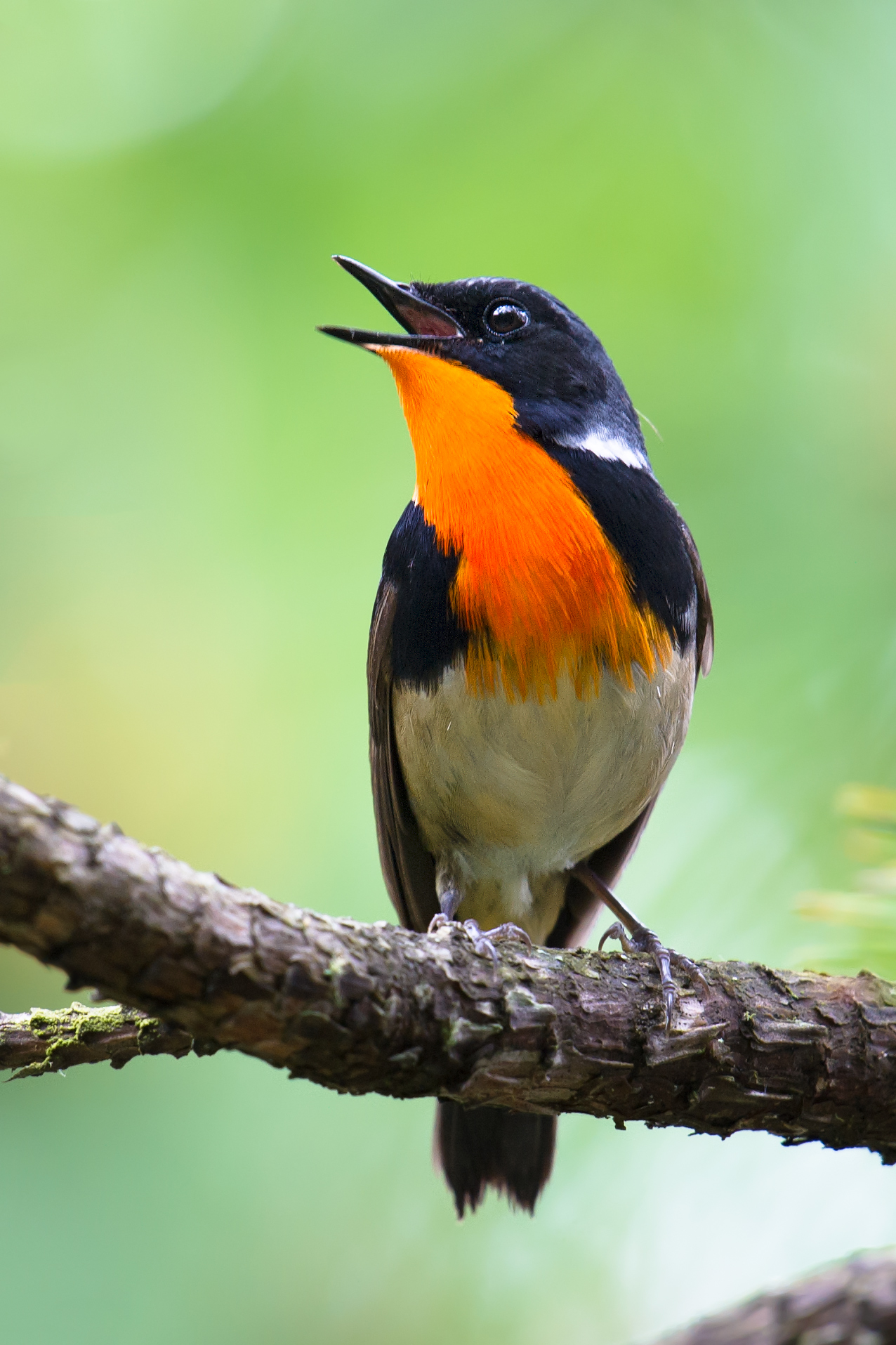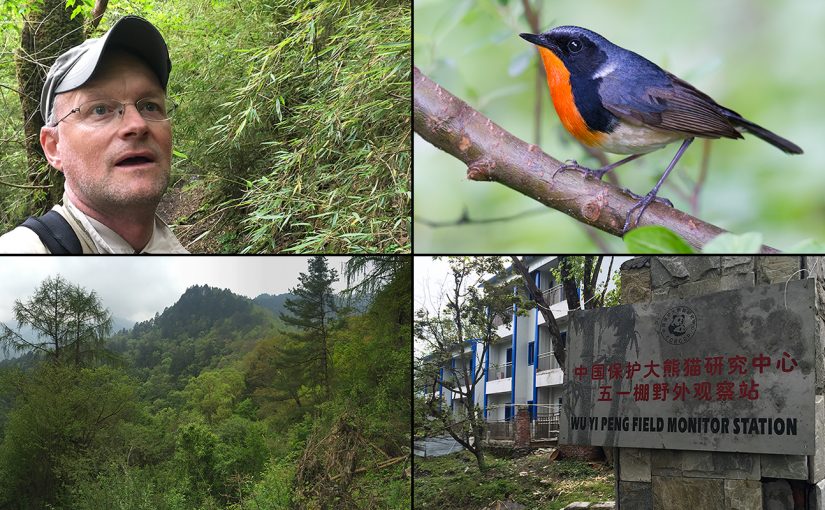by Craig Brelsford
Founder, shanghaibirding.com
Wuyipeng Field Monitoring Station (30.994128, 103.159845) is one of the best birding sites in China. Set in thick forest 550 m (1,800 ft.) above the Shaotang River Valley at an elevation of 2570 m (8,430 ft.), the abandoned panda research station near Wolong, Sichuan is reachable only by foot. The steep climb and complex avifauna intimidate the young birder—but challenge and fulfill the experienced birder.
I know, for I have been both. In July 2010 I made my first visit to Wuyipeng. I was a new birder, alone and untrained. Wuyipeng overwhelmed me. When I returned in 2017, I had seven years of study under my belt, I was with my mentor Michael Grunwell, and we hardly missed a bird.
In 2010 I was hooked on bird photography. I carried to the top my equipment, all 10.5 kg (23 lbs.) of it. At the time, I had only one way of intensely experiencing a bird—by photographing it. Photography was my sole pathway to intensity because, at the time, I knew little about birds.
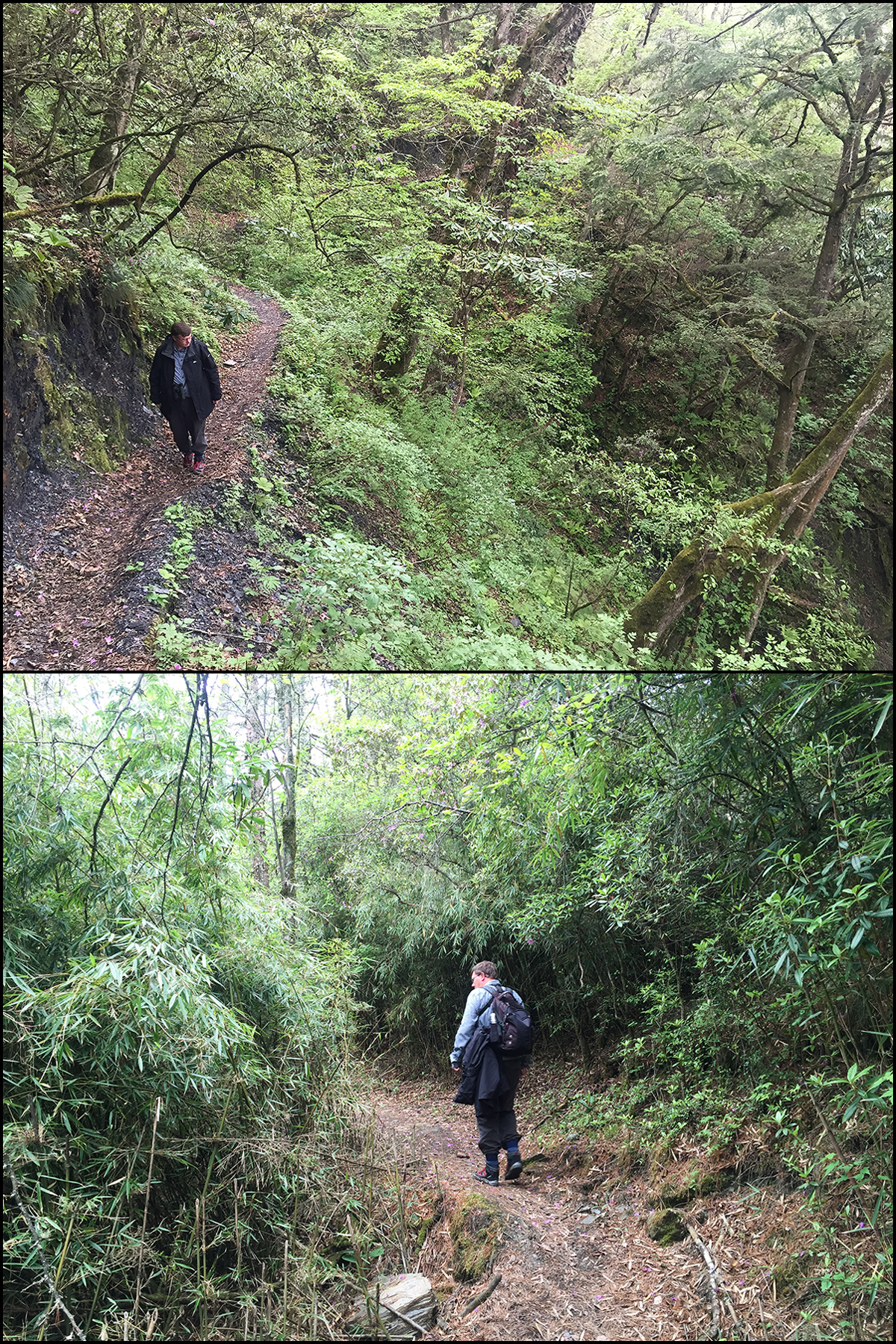
The more I learned about birds, the less obsessed I became with photographing them. I developed new ways of relating to birds—observing them closely, studying their habitats, recording their voices, and writing about them.
And crucially, by 2017 I had made friends with birders who know more than I about birds. Michael Grunwell is one of them. Michael has been building his life list since he was a teen-ager in the 1970s. Michael not only knows birds, but he also knows how to know birds.
Like your mother at the grocery store, Michael arrives at a site with a shopping list—his target species. He has read up on the species he wants and knows what to look for.
For example: Michael and I arrive at a creek deep in the forest. “Creekside habo!” I say to Michael. “What’s your target?”
“Play Chinese Wren-babbler,” Michael says.
I pull out my iPhone and find a recording of Chinese Cupwing that I downloaded from xeno-canto.org. I Bluetooth it through my speaker, and within seconds I get a response.
Chinese Cupwing Pnoepyga mutica, along stream (30.991680, 103.160400) near Wuyipeng Field Monitoring Station, Wolong, Sichuan. Elev. 2570 m (8,430 ft.). 20 May (0:03; 1.7 MB)
Had my birding skills remained at the level of 2010, and had I not partly assimilated Michael’s birding style, then I would have missed Chinese Cupwing and many other species. I would have been bored, for in the dark, lush forest, photo opportunities are few (and in any case, this time I wisely decided not to lug my camera up the hill). Because I had progressed beyond photography, I was highly stimulated and had a sense of control. It was a great feeling.

Even a non-birder would feel good up there. Wuyipeng achieves a perfect balance: It is developed just enough to allow access, being one of the few places in the area with a good hiking trail; yet it remains a wilderness, for the steep climb is a formidable barrier, and visitors are few. In 2010 and again in 2017, we saw no one.
Making Wuyipeng even more interesting is the greater region of which it is a part. Sichuan and neighboring Yunnan are, ornithologically speaking, the Center of Asia. Himalaya, Indo-Malaya, Palearctica—like tectonic plates, the great eco-regions collide here. Various groups of birds, most notably the parrotbills, have their center of distribution in or near Sichuan (Robson).
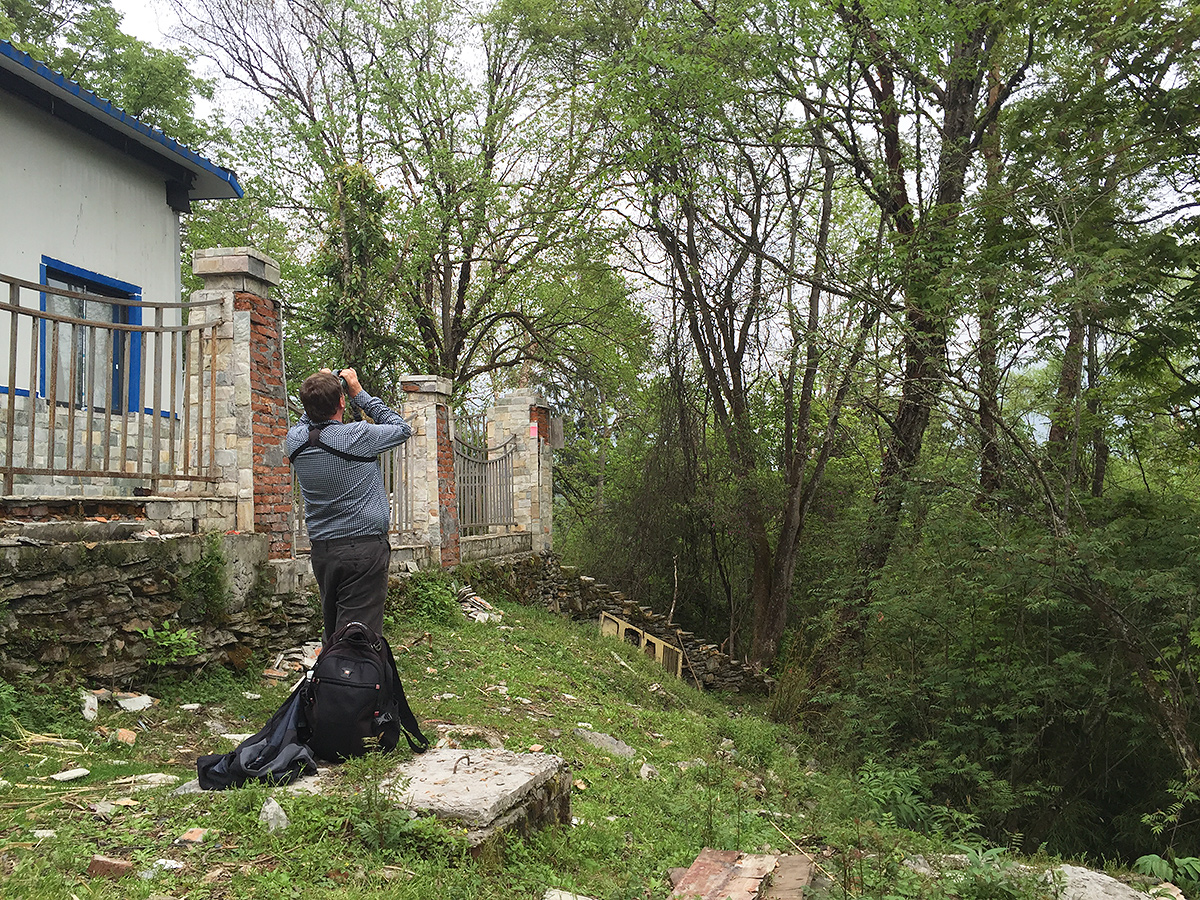
The avian diversity here is unmatched in the temperate world. During a bird wave at the station, a single tree held six species of tit: Fire-capped Tit Cephalopyrus flammiceps, Yellow-browed Tit Sylviparus modestus, Coal Tit Periparus ater, Yellow-bellied Tit Pardaliparus venustulus, Pere David’s Tit Poecile davidi, and Green-backed Tit Parus monticolus. That is half as many species of parid in a single tree as are found in the United States and Canada.
The mountain also yielded six members of a single genus, Phylloscopus: Chinese Leaf Warbler P. yunnanensis, Greenish Warbler P. trochiloides, Large-billed Leaf Warbler P. magnirostris, Claudia’s Leaf Warbler P. claudiae, Emei Leaf Warbler P. emeiensis, and Sichuan Leaf Warbler P. forresti.
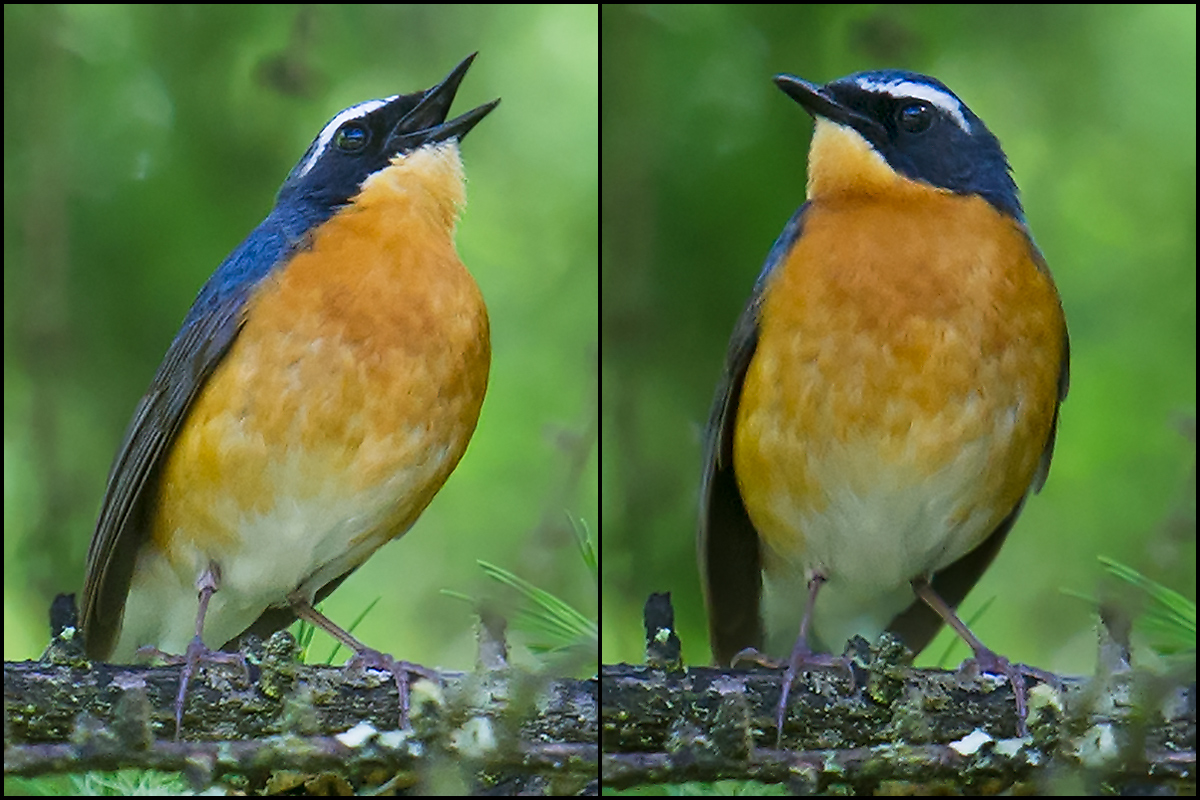
We had Firethroat singing in thick undergrowth on the hillside, and just a few meters away a heart-stopping encounter with male Temminck’s Tragopan tiptoeing across the trail. Golden Pheasant called unseen, exquisite Indian Blue Robin and Chestnut-headed Tesia were singing, and Golden-breasted Fulvetta added color. We had a migrating flock of 40 Tibetan Serin.
We noted 49 species in all. Michael called 20 May one of his best birding days in his four years in China. I called it one of my best birding days, period.
Wuyipeng was the biggest but certainly not the only highlight of our four days, 18–21 May, in the Wolong-Balangshan area. Michael and I covered altitudes between 2000 m (6,560 ft.) and 4500 m (14,760 ft.) on the 79-km (49-mi.) stretch of the S303 between Wolong and Rilong. We noted 110 species.
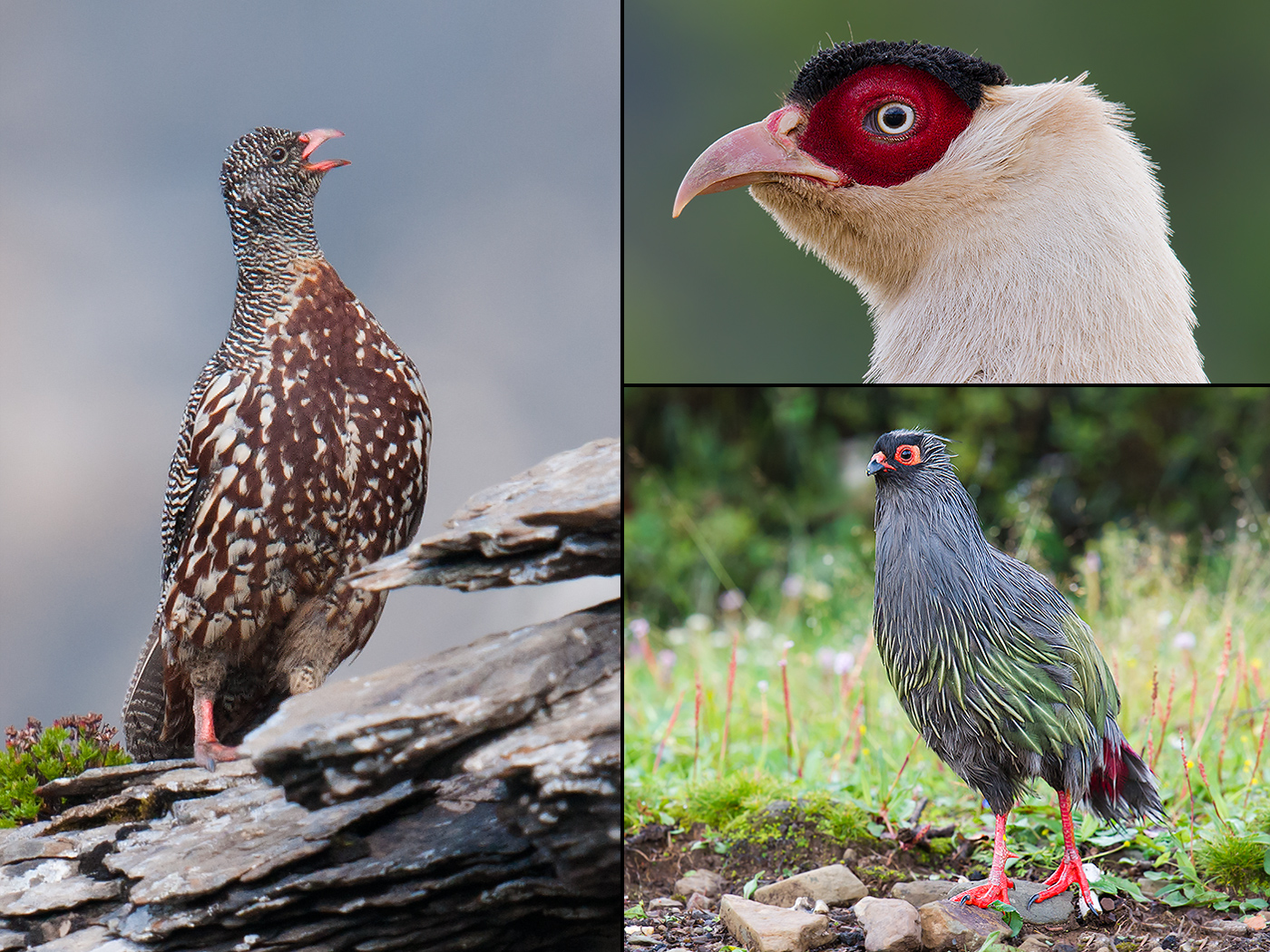
Gamebirds were richly represented. We noted eight species: Snow Partridge Lerwa lerwa, Verreaux’s Monal-Partridge Tetraophasis obscurus, Blood Pheasant Ithaginis cruentus, Temminck’s Tragopan Tragopan temminckii, Koklass Pheasant Pucrasia macrolopha, White Eared Pheasant Crossoptilon crossoptilon, Golden Pheasant Chrysolophus pictus, and Lady Amherst’s Pheasant C. amherstiae.
At the famous tunnel area (30.877921, 102.966226) we made only a half-hearted effort to see Chinese Monal, which Michael had seen before. Higher up, we looked for but missed Tibetan Snowcock.
To the list of the six leaf-warbler species from Wuyipeng we added Alpine/Tickell’s Leaf Warbler Phylloscopus affinis occisinensis, Buff-barred Warbler P. pulcher, and Hume’s Leaf Warbler P. humei, giving us a total of nine over the four days.
We found Collared Grosbeak and Sichuan Thrush along the S303, we spotted Grandala on the slopes at high altitude, and in the alpine scrub we found Sichuan Tit, Chinese Rubythroat, and Chinese Fulvetta.
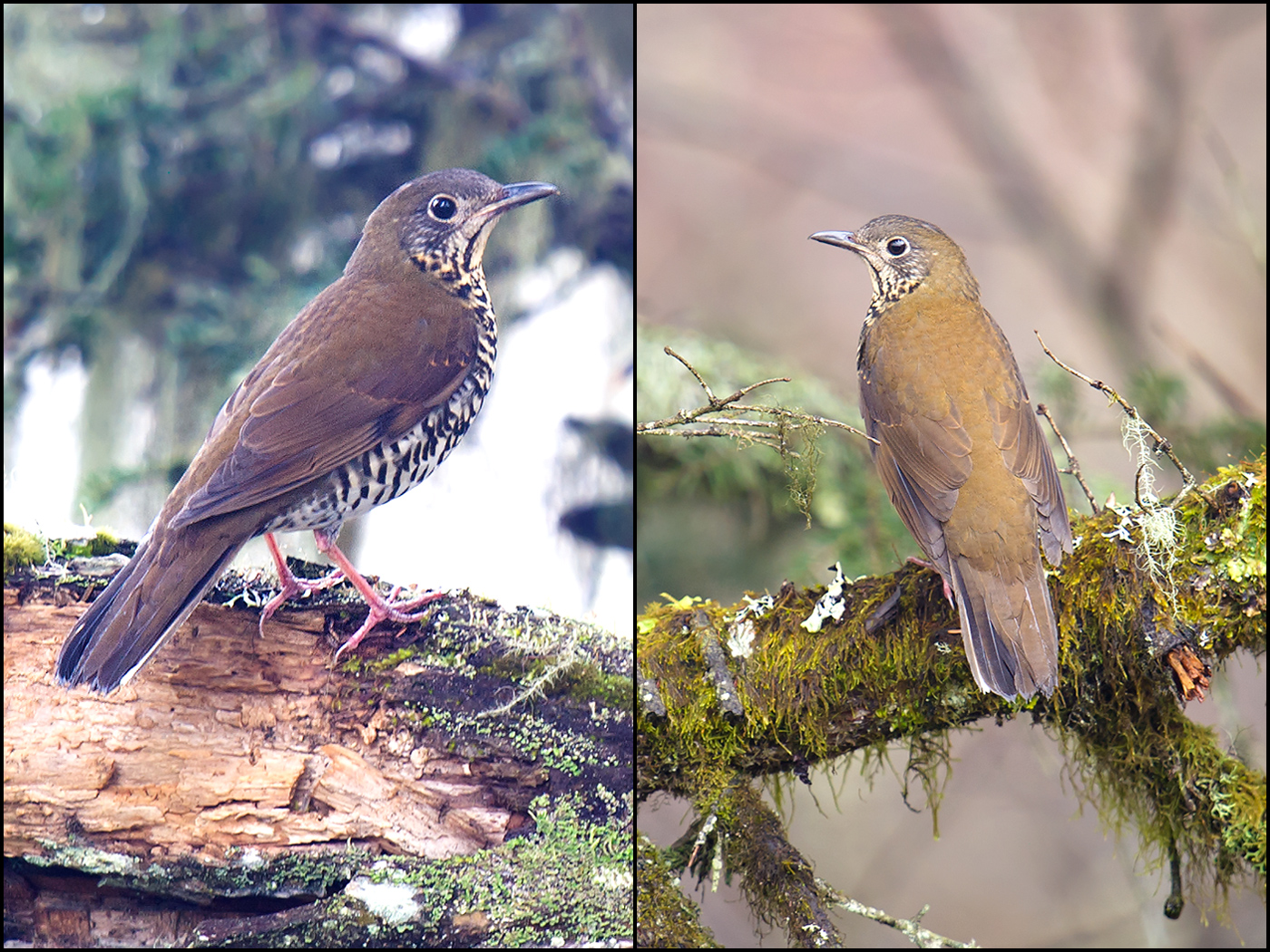
The route from Wolong over the Balangshan Pass to Rilong is a marvel, one of the great drives of China. The new Balangshan Tunnel reduces the driving distance between Wolong and Rilong from 96 km to 79 km.
A series of tunnels linking Wolong to the G213 and Chengdu has been completed, a monumental feat of engineering.
With the improvements in infrastructure, and with the continued expansion of the rental-car industry in China, Wuyipeng and Balangshan are now open to Shanghai birders with only a few days to spare, as was the case with Michael and me.
After a full workday 17 May, we flew that night from Shanghai’s Hongqiao Airport to Chengdu. We picked up our car from Shenzhou, covered in three hours the 125 km (78 mi.) to Wolong, and at daylight on 18 May were taking in the dawn chorus at Lama Temple.
We stayed at the clean Lín Huì Fàndiàn (临惠饭店, +86 153-5143-1887, +86 152-8151-1256). For our night on the Rilong side, I once again used Kāi Fù Shān Zhuāng (开富山庄, +86 150-8250-0382).
We birded half a day on 21 May before calling it a trip.
As Michael and I departed the mountains for Chengdu, zipping through the world-class tunnels, we reviewed the eventful past four days. I thought further back to 2010, when the road to Wolong was bumpy, dusty, and dangerous, and when I knew little about birds.
I have become a better birder. Wuyipeng and Balangshan have become easier places to bird. Progress is occurring, and on more front than one.
VIDEOS
Quiet moments in the forest near Wuyipeng.
In 2010, I carried my heavy equipment to the top. I was laughing even then.
SOUND RECORDINGS
Below, a selection of Craig Brelsford’s sound-recordings from the Sichuan trip. For even more sound-recordings and photos, and for our day lists from Sichuan, please see the eBird citations in the Bibliography below.
Himalayan Cuckoo Cuculus saturatus, Wuyipeng, 20 May (0:16; 1.5 MB)
Firethroat Calliope pectardens, trail to Wuyipeng, 20 May. 30.999205, 103.154595. (1:54; 6.1 MB)
Indian Blue Robin Larvivora brunnea, Lama Temple, 18 May (0:43; 2.5 MB)
Chestnut-headed Tesia Cettia castaneocoronata, Wuyipeng, 20 May (0:48; 3.5 MB)
Sichuan Thrush Zoothera griseiceps, along S303, 21 May. 30.891258, 102.975770. (0:04; 987 KB)
Martens’s Warbler Seicercus omeiensis, Lama Temple, 19 May (2:54; 8.6 MB)
BIRDS NOTED BY MICHAEL GRUNWELL AND CRAIG BRELSFORD IN SICHUAN, 18–21 MAY (110 SPECIES)
Hyperlinks connect to entries in Craig Brelsford’s Photographic Field Guide to the Birds of China:
Blood Pheasant Ithaginis cruentus
Snow Partridge Lerwa lerwa
Verreaux’s Monal-Partridge Tetraophasis obscurus
Temminck’s Tragopan Tragopan temminckii
Golden Pheasant Chrysolophus pictus
Lady Amherst’s Pheasant C. amherstiae
White Eared Pheasant Crossoptilon crossoptilon
Koklass Pheasant Pucrasia macrolopha
Bearded Vulture Gypaetus barbatus
Crested Honey Buzzard Pernis ptilorhynchus
Himalayan Vulture Gyps himalayensis
Golden Eagle Aquila chrysaetos
Feral Pigeon (Rock Dove) Columba livia
Snow Pigeon C. leuconota
Speckled Wood Pigeon C. hodgsonii
Asian Koel Eudynamys scolopaceus
Large Hawk-Cuckoo Hierococcyx sparverioides
Himalayan Cuckoo Cuculus saturatus
Common Cuckoo C. canorus
Salim Ali’s Swift Apus salimalii
Great Barbet Psilopogon virens
Great Spotted Woodpecker Dendrocopos major
Bay Woodpecker Blythipicus pyrrhotis
Saker Falcon Falco cherrug
Long-tailed Minivet Pericrocotus ethologus
Grey-backed Shrike Lanius tephronotus
Red-billed Blue Magpie Urocissa erythroryncha
Spotted Nutcracker Nucifraga caryocatactes
Red-billed Chough Pyrrhocorax pyrrhocorax
Large-billed Crow Corvus macrorhynchos
Barn Swallow Hirundo rustica
Asian House Martin Delichon dasypus
Fire-capped Tit Cephalopyrus flammiceps
Yellow-browed Tit Sylviparus modestus
Coal Tit Periparus ater
Rufous-vented Tit P. rubidiventris
Yellow-bellied Tit P. venustulus
Pere David’s Tit Poecile davidi
Sichuan Tit P. weigoldicus
Green-backed Tit Parus monticolus
Black-browed Bushtit Aegithalos iouschistos
Chestnut-vented Nuthatch Sitta nagaensis
Hodgson’s Treecreeper Certhia hodgsoni
Eurasian Wren Troglodytes troglodytes
Brown Dipper Cinclus pallasii
Collared Finchbill Spizixos semitorques
Light-vented Bulbul Pycnonotus sinensis
Chinese Cupwing Pnoepyga mutica
Pygmy Cupwing P. pusilla
Chestnut-headed Tesia Cettia castaneocoronata
Brown-flanked Bush Warbler Horornis fortipes
Yellow-bellied Bush Warbler H. acanthizoides
Aberrant Bush Warbler H. flavolivaceus
Alpine/Tickell’s Leaf Warbler Phylloscopus affinis occisinensis
Buff-barred Warbler P. pulcher
Sichuan Leaf Warbler P. forresti
Chinese Leaf Warbler P. yunnanensis
Hume’s Leaf Warbler P. humei
Greenish Warbler P. trochiloides
Large-billed Leaf Warbler P. magnirostris
Claudia’s Leaf Warbler P. claudiae
Emei Leaf Warbler P. emeiensis
Martens’s Warbler P. omeiensis
Bianchi’s Warbler P. valentini
Rufous-capped Babbler Cyanoderma ruficeps
Black-streaked Scimitar Babbler Pomatorhinus gravivox
Chinese Babax Babax lanceolatus
Spotted Laughingthrush Garrulax ocellatus
Giant Laughingthrush G. maximus
Elliot’s Laughingthrush Trochalopteron elliotii
Golden-breasted Fulvetta Lioparus chrysotis
White-browed Fulvetta Fulvetta vinipectus
Chinese Fulvetta F. striaticollis
Grey-hooded Fulvetta F. cinereiceps
White-collared Yuhina Yuhina diademata
Chestnut-flanked White-eye Zosterops erythropleurus
Sichuan Thrush Zoothera griseiceps
Chestnut Thrush Turdus rubrocanus
Fujian Niltava Niltava davidi
Verditer Flycatcher Eumyias thalassinus
Indian Blue Robin Larvivora brunnea
Chinese Rubythroat Calliope tschebaiewi
Firethroat C. pectardens
Grandala Grandala coelicolor
Himalayan Bluetail Tarsiger rufilatus
Slaty-blue Flycatcher Ficedula tricolor
Rufous-gorgeted Flycatcher F. strophiata
Blue-fronted Redstart Phoenicurus frontalis
Plumbeous Water Redstart P. fuliginosus
White-capped Redstart P. leucocephalus
Daurian Redstart P. auroreus
Eurasian Tree Sparrow Passer montanus
Mrs. Gould’s Sunbird Aethopyga gouldiae
Alpine Accentor Prunella collaris
Rufous-breasted Accentor P. strophiata
Grey Wagtail Motacilla cinerea
White Wagtail M. alba
Rosy Pipit Anthus roseatus
Olive-backed Pipit A. hodgsoni
Plain Mountain Finch Leucosticte nemoricola
Dark-breasted Rosefinch Carpodacus nipalensis
Common Rosefinch C. erythrinus
Pink-rumped Rosefinch C. waltoni
Vinaceous Rosefinch C. vinaceus
Sharpe’s Rosefinch C. verreauxii
Chinese White-browed Rosefinch C. dubius
Twite Carduelis flavirostris
Tibetan Serin Spinus thibetanus
Collared Grosbeak Mycerobas affinis
Slaty Bunting Emberiza siemsseni
LIST OF PLACE NAMES

Balangshan Pass (Bālángshān Kǒu [八郎山口]): mountain divide & birding area, Sichuan. Elev. 4481 m (14,701 ft.). 30.9108, 102.8947.
Lama Monastery: see Lama Temple.
Lama Temple (Lǎma Sì [喇嘛寺]): birding site & place of worship, Wolong. Elev. 2230 m (7,320 ft.). 31.029363, 103.166572.
Rilong (Rìlóng Zhèn [日隆镇]) (30.9935765, 102.8299713): town W of Balangshan Pass on S303. Also known as Sìgūniángshān Zhèn.
Sìgūniángshān Zhèn (四姑娘山镇): another name for Rilong.
Wolong (Wòlóng Zhèn [卧龙镇]): town E of Balangshan Pass on S303. 31.0395827, 103.1984586.
Wuyipeng Field Monitoring Station (Zhōngguó Bǎohù Dàxióngmāo Yánjiū Zhōngxīn, Wǔyīpéng Yěwài Guāncházhàn [中国保护大熊猫研究中心, 五一棚野外观察站]): research center in thick forest near Wolong. Damaged & abandoned after Wenchuan Earthquake of 12 May 2008. Elev. 2570 m (8,430 ft.). 30.994128, 103.159845. Begin your walk at Jīnjiāpō (金家坡, 31.004395, 103.151987). Park your car at any of the local folks’ homes.
REFERENCES
Brelsford, C. 2017. eBird Checklist: https://ebird.org/ebird/view/checklist/S36952551. eBird: An online database of bird distribution and abundance [Web application]. eBird, Ithaca, New York, USA. (Accessed: 27 May 2022). Note: This is the first of five lists we made for 18 May 2017. This list covers Lama Monastery.
———. 2017. eBird Checklist: https://ebird.org/ebird/view/checklist/S36954305. Note: This is list 2/5 for 18 May 2017.
———. 2017. eBird Checklist: https://ebird.org/ebird/view/checklist/S36954394. List 3/5, 18 May 2017.
———. 2017. eBird Checklist: https://ebird.org/ebird/view/checklist/S36954414. List 4/5, 18 May 2017.
———. 2017. eBird Checklist: https://ebird.org/ebird/view/checklist/S36954445. List 5/5, 18 May 2017.
———. 2017. eBird Checklist: https://ebird.org/ebird/view/checklist/S36980196. List 1/6, 19 May 2017.
———. 2017. eBird Checklist: https://ebird.org/ebird/view/checklist/S36980217. List 2/6, 19 May 2017.
———. 2017. eBird Checklist: https://ebird.org/ebird/view/checklist/S36980192. List 3/6, 19 May 2017.
———. 2017. eBird Checklist: https://ebird.org/ebird/view/checklist/S36979053. List 4/6, 19 May 2017.
———. 2017. eBird Checklist: https://ebird.org/ebird/view/checklist/S36980247. List 5/6, 19 May 2017.
———. 2017. eBird Checklist: https://ebird.org/ebird/view/checklist/S36978948. List 6/6, 19 May 2017.
———. 2017. eBird Checklist: https://ebird.org/ebird/view/checklist/S37003578. List of birds noted at Wuyipeng, 20 May 2017.
———. 2017. eBird Checklist: https://ebird.org/ebird/view/checklist/S37021548. List 1/5, 21 May 2017.
———. 2017. eBird Checklist: https://ebird.org/ebird/view/checklist/S37022288. List 2/5, 21 May 2017.
———. 2017. eBird Checklist: https://ebird.org/ebird/view/checklist/S37026720. List 3/5, 21 May 2017.
———. 2017. eBird Checklist: https://ebird.org/ebird/view/checklist/S37029131. List 4/5, 21 May 2017.
———. 2017. eBird Checklist: https://ebird.org/ebird/view/checklist/S37081320. List 5/5, 21 May 2017.
Collar, N.J. (2005). Family Turdidae (Thrushes). P. 748 (Indian Blue Robin) in del Hoyo, J., Elliott, A. & Christie, D.A. eds. (2005). Handbook of the Birds of the World. Vol. 10. Cuckoo-shrikes to Thrushes. Lynx Edicions, Barcelona, Spain.
eBird. 2017. eBird hotspot: Wuyipeng Research Station, Sichuan, CN: https://ebird.org/ebird/hotspot/L947367. eBird: An online database of bird distribution and abundance [Web application]. eBird, Ithaca, New York. (Accessed: 27 May 2022).
Robson, C. (2006). Family Paradoxornithidae (Parrotbills). P. 292 in del Hoyo, J., Elliott, A. & Christie, D.A. eds. (2006). Handbook of the Birds of the World. Vol. 12. Picathartes to Tits and Chickadees. Lynx Edicions, Barcelona, Spain.
Featured image: Themes from Wuyipeng. Clockwise from top L: Craig Brelsford in sea of bamboo; male Firethroat Calliope pectardens; sign at Wuyipeng Field Monitoring Station; rich forest near station. (Craig Brelsford)

